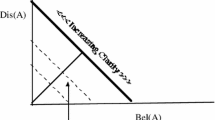Abstract
We describe the Dempster–Shafer belief structure and provide some of its basic properties. We introduce the plausibility and belief measures associated with a belief structure. We note that these are not the only measures that can be associated with a belief structure. We describe a general approach for generating a class of measures that can be associated with a belief structure using a monotonic function on the unit interval, called a weight generating function. We study a number of these functions and the measures that result. We show how to use weight-generating functions to obtain dual measures from a belief structure. We show the role of belief structures in representing imprecise probability distributions. We describe the use of dual measures, other then plausibility and belief, to provide alternative bounding intervals for the imprecise probabilities associated with a belief structure. We investigate the problem of decision making under belief structure type uncertain. We discuss two approaches to this decision problem. One of which is based on an expected value of the OWA aggregation of the payoffs associated with the focal elements. The second approach is based on using the Choquet integral of a measure generated from the belief structure. We show the equivalence of these approaches.




Similar content being viewed by others
References
Dempster, A. P. (2008). The Dempster–Shafer calculus for statisticians. International Journal of Approximate Reasoning, 48, 365–377.
Klement, E. P., Mesiar, R., Spizzichino, F., & Stupnanová, A. (2014). Universal integrals based on copulas. Fuzzy Optimization and Decision Making, 13, 273–286.
O’Hagan, M. (1990). Using maximum entropy-ordered weighted averaging to construct a fuzzy neuron. In Proceedings 24th annual IEEE Asilomar conference on signals, systems and computers, Pacific Grove, CA (pp 618–623).
Shafer, G. (1976). A mathematical theory of evidence. Princeton, NJ: Princeton University Press.
Smets, P. (2005). Decision making in the TBM: The necessity of the pignistic transformation. International Journal of Approximate Reasoning, 38, 133–147.
Smets, P., & Kennes, R. (1994). The transferable belief model. Artificial Intelligence, 66, 191–234.
Sugeno, M. (1977). Fuzzy measures and fuzzy integrals: A survey. In M. M. Gupta, G. N. Saridis, & B. R. Gaines (Eds.), Fuzzy automata and decision process (pp. 89–102). Amsterdam: North-Holland Publisher.
Wang, Z., & Klir, G. J. (2009). Generalized measure theory. New York: Springer.
Wang, Z., Yang, R., & Leung, K.-S. (2010). Nonlinear integrals and their applications in data mining. Singapore: World Scientific.
Yager, R. R. (1988). On ordered weighted averaging aggregation operators in multi-criteria decision making. IEEE Transactions on Systems, Man and Cybernetics, 18, 183–190.
Yager, R. R. (1992). Decision making under Dempster–Shafer uncertainties. International Journal of General Systems, 20, 233–245.
Yager, R. R. (1996). Quantifier guided aggregation using OWA operators. International Journal of Intelligent Systems, 11, 49–73.
Yager, R. R. (1997). On the inclusion of importances in OWA aggregations. In R. R. Yager & J. Kacprzyk (Eds.), The ordered weighted averaging operators: Theory and applications (pp. 41–59). Norwell, MA: Kluwer Academic Publishers.
Yager, R. R. (1999). A class of fuzzy measures generated from a Dempster–Shafer belief structure. International Journal of Intelligent Systems, 14, 1239–1247.
Yager, R. R., & Alajlan, N. (2012). Measure based representation of uncertain information. Fuzzy Optimization and Decision Making, 11, 363–385.
Yager, R. R., & Alajlan, N. (2014). On characterizing features of OWA aggregation operators. Fuzzy Optimization and Decision Making, 13, 1–32.
Yager, R. R. & Liu L. (2008). (Dempster, A. P.&Shafer, G. Advisory Editors). Classic works of the Dempster–Shafer theory of belief functions. Heidelberg: Springer.
Zadeh, L. A. (1978). Fuzzy sets as a basis for a theory of possibility. Fuzzy Sets and Systems, 1, 3–28.
Zadeh, L. A. (1979). Fuzzy sets and information granularity. In M. M. Gupta, R. K. Ragade, & R. R. Yager (Eds.), Advances in fuzzy set theory and applications (pp. 3–18). Amsterdam: North-Holland.
Author information
Authors and Affiliations
Corresponding author
Rights and permissions
About this article
Cite this article
Yager, R.R. Belief structures, weight generating functions and decision-making. Fuzzy Optim Decis Making 16, 1–21 (2017). https://doi.org/10.1007/s10700-016-9236-x
Published:
Issue Date:
DOI: https://doi.org/10.1007/s10700-016-9236-x



